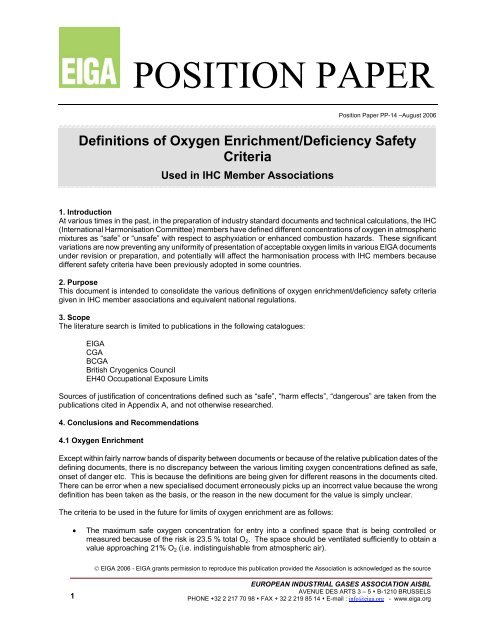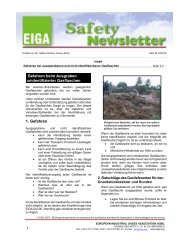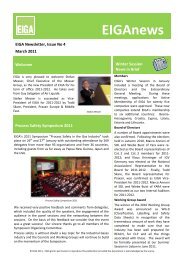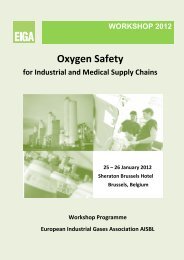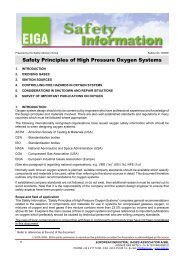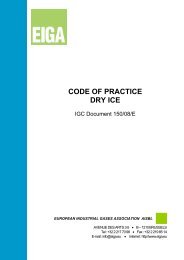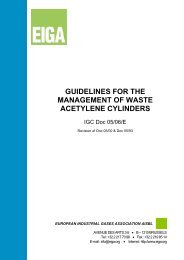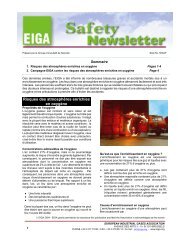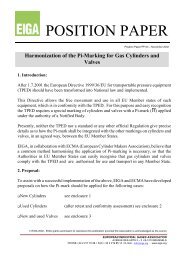Definitions of Oxygen Enrichment/Deficiency Safety Criteria - eiga
Definitions of Oxygen Enrichment/Deficiency Safety Criteria - eiga
Definitions of Oxygen Enrichment/Deficiency Safety Criteria - eiga
You also want an ePaper? Increase the reach of your titles
YUMPU automatically turns print PDFs into web optimized ePapers that Google loves.
1<br />
POSITION PAPER<br />
Position Paper PP-14 –August 2006<br />
<strong>Definitions</strong> <strong>of</strong> <strong>Oxygen</strong> <strong>Enrichment</strong>/<strong>Deficiency</strong> <strong>Safety</strong><br />
<strong>Criteria</strong><br />
Used in IHC Member Associations<br />
1. Introduction<br />
At various times in the past, in the preparation <strong>of</strong> industry standard documents and technical calculations, the IHC<br />
(International Harmonisation Committee) members have defined different concentrations <strong>of</strong> oxygen in atmospheric<br />
mixtures as “safe” or “unsafe” with respect to asphyxiation or enhanced combustion hazards. These significant<br />
variations are now preventing any uniformity <strong>of</strong> presentation <strong>of</strong> acceptable oxygen limits in various EIGA documents<br />
under revision or preparation, and potentially will affect the harmonisation process with IHC members because<br />
different safety criteria have been previously adopted in some countries.<br />
2. Purpose<br />
This document is intended to consolidate the various definitions <strong>of</strong> oxygen enrichment/deficiency safety criteria<br />
given in IHC member associations and equivalent national regulations.<br />
3. Scope<br />
The literature search is limited to publications in the following catalogues:<br />
EIGA<br />
CGA<br />
BCGA<br />
British Cryogenics Council<br />
EH40 Occupational Exposure Limits<br />
Sources <strong>of</strong> justification <strong>of</strong> concentrations defined such as “safe”, “harm effects”, “dangerous” are taken from the<br />
publications cited in Appendix A, and not otherwise researched.<br />
4. Conclusions and Recommendations<br />
4.1 <strong>Oxygen</strong> <strong>Enrichment</strong><br />
Except within fairly narrow bands <strong>of</strong> disparity between documents or because <strong>of</strong> the relative publication dates <strong>of</strong> the<br />
defining documents, there is no discrepancy between the various limiting oxygen concentrations defined as safe,<br />
onset <strong>of</strong> danger etc. This is because the definitions are being given for different reasons in the documents cited.<br />
There can be error when a new specialised document erroneously picks up an incorrect value because the wrong<br />
definition has been taken as the basis, or the reason in the new document for the value is simply unclear.<br />
The criteria to be used in the future for limits <strong>of</strong> oxygen enrichment are as follows:<br />
• The maximum safe oxygen concentration for entry into a confined space that is being controlled or<br />
measured because <strong>of</strong> the risk is 23.5 % total O2. The space should be ventilated sufficiently to obtain a<br />
value approaching 21% O2 (i.e. indistinguishable from atmospheric air).<br />
© EIGA 2006 - EIGA grants permission to reproduce this publication provided the Association is acknowledged as the source<br />
EUROPEAN INDUSTRIAL GASES ASSOCIATION AISBL<br />
AVENUE DES ARTS 3 – 5 � B-1210 BRUSSELS<br />
PHONE +32 2 217 70 98 � FAX + 32 2 219 85 14 � E-mail : info@<strong>eiga</strong>.org - www.<strong>eiga</strong>.org
Position Paper PP-14 – August 2006 Page 2/5<br />
• For cases <strong>of</strong> leakage, venting or uncontrolled release <strong>of</strong> oxygen into the outdoor atmosphere, there is no<br />
risk <strong>of</strong> harm in clouds containing up to 25% O2. At anticipated level above 25% O2 it may be possible by<br />
means <strong>of</strong> risk assessments to determine that such atmospheres can be safely entered with appropriate<br />
control: e.g. there is no permitted smoking in an area where venting is possible, or hot work is controlled by<br />
permit because <strong>of</strong> the risks <strong>of</strong> venting.<br />
• For purposes <strong>of</strong> quantification, or for cases <strong>of</strong> reporting boundary conditions from predicted release cases<br />
calculated by dispersion, there is an anticipated lethal risk from atmospheres with concentrations <strong>of</strong> 35% O2<br />
and higher.<br />
• Care has to be taken with regard to special circumstances such as definition <strong>of</strong> safety from releases<br />
involving cold oxygen clouds that may accumulate in depressions or pits, or from atmospheric<br />
concentrations that might enter air intakes to compressors, blowers or Heating Ventilation Air Conditioning<br />
(HVAC) units, where the machinery design anticipates that only atmospheric air (i.e. 21% O2) could be<br />
present.<br />
• These criteria are only designed to cover cases <strong>of</strong> excess O2 concentration in anticipated atmospheric air,<br />
they cannot be justified in any other cases e.g. oxygen – flammable gas mixtures or gases used for medical<br />
purposes.<br />
4.2 <strong>Oxygen</strong> <strong>Deficiency</strong><br />
Compared with the near uniformity <strong>of</strong> the oxygen limits, there is little agreement between the document sources on<br />
the tolerability levels for oxygen deficiency. This appears to be because the base physiological data that are being<br />
cited have significantly varying levels for the onset <strong>of</strong> different symptoms especially at levels where the situation is<br />
reversible. Also loss <strong>of</strong> concentration, coordination or judgement are cited at relatively high O2 concentrations,<br />
where there is no apparent danger in itself but for an individual engaged in a complex task there might be potentially<br />
lethal knock on effects (e.g. falling, failing to carry out instructions, or accidents with machines or vehicles). The<br />
result is a general principle to err on side <strong>of</strong> caution whatever the data. Nevertheless it is possible to recommend<br />
criteria for different conditions under review on an equivalent basis to the results in 5.1 above.<br />
The criteria to be used in the future for limits <strong>of</strong> oxygen deficiency are as follows:<br />
The minimum safe oxygen concentration for entry into a space that is being controlled or measured because <strong>of</strong> the<br />
risk is 19.5% total O2. The space should be ventilated sufficiently to obtain a value closer to 21% O2 (i.e.<br />
indistinguishable from atmospheric air). There are applications with oxygen concentrations below 19.5% where<br />
entry is permitted provided further precautions are taken in accordance with proper risk assessment and national<br />
regulations (e.g. fire suppression).<br />
• For cases <strong>of</strong> leakage, venting or uncontrolled release <strong>of</strong> inert gases into the outdoor atmosphere, there is<br />
no anticipated risk <strong>of</strong> harm in clouds containing at least 17% O2.<br />
• For purposes <strong>of</strong> quantification, or for cases <strong>of</strong> reporting boundary conditions from predicted release cases<br />
calculated by dispersion, there is an anticipated lethal risk from atmospheres with concentrations <strong>of</strong> 12.5%<br />
O2 and below.<br />
• Care should be taken in determining what circumstances are anticipated for the people at the boundary<br />
conditions in deciding to use the above values, which are for a person standing in the open air not under<br />
stress or physical exertion. For example, if people within the anticipated release area are driving or using<br />
tools or machinery, the risk or injury <strong>of</strong> death may result in atmospheres containing higher than 12.5% O2<br />
because <strong>of</strong> the knock on effects from unnoticed loss <strong>of</strong> co-ordination or judgement.<br />
2<br />
EUROPEAN INDUSTRIAL GASES ASSOCIATION AISBL<br />
AVENUE DES ARTS 3 – 5 � B-1210 BRUSSELS<br />
PHONE +32 2 217 70 98 � FAX + 32 2 219 85 14 � E-mail : info@<strong>eiga</strong>.org - www.<strong>eiga</strong>.org
APPENDIX A Data Sources<br />
1 <strong>Oxygen</strong> <strong>Enrichment</strong><br />
3<br />
Position Paper PP-14 – August 2006 Page 3/5<br />
A. IGC Document 04/00/E “Fire hazard <strong>of</strong> oxygen and oxygen enriched atmospheres”<br />
� For safe entry into a space that can subject to oxygen enrichment, the concentration should not exceed<br />
22.5% O2. Concentrations <strong>of</strong> 23% or more are potentially dangerous.<br />
B. BCGA Technical Report TR2 (1999) “<br />
The probability <strong>of</strong> fatality in O2 enriched atmospheres due to spillage <strong>of</strong> liquid O2 (LOX)”<br />
� The dangerous dose for LOX spills has been defined with the HSE as 35% total O2 concentration. (This is<br />
demonstrated in the data presented as approximately 0.5% probability <strong>of</strong> fatality or serious injury for<br />
members <strong>of</strong> the general public resulting from uncontrollable ignition sources).<br />
� The report is justifying raising the dangerous dose level determined in the earlier BCGA TR1 report from<br />
30% O2 by reference to recalculated data for the same probability <strong>of</strong> fatality cut-<strong>of</strong>f criteria.<br />
� Although not mentioned in the conclusions, there was no change to be made to the safe max.limit <strong>of</strong> oxygen<br />
concentration <strong>of</strong> 25% derived in the earlier document because the variation in fatality rate between the two<br />
documents was not significant.<br />
C. OSHA 29 CFR1920.146 Hazardous atmosphere<br />
� Hazardous atmosphere means an atmosphere that may expose employees to the risk <strong>of</strong> death,<br />
incapacitation, impairment <strong>of</strong> ability to self-rescue (that is, escape unaided from a permit space), injury, or<br />
acute illness from one or more <strong>of</strong> the following causes:<br />
Atmospheric oxygen concentration below 19.5% or above 23.5%<br />
D. BCGA Technical Report TR1 (1984) “<br />
A method for estimating the <strong>of</strong>fsite risks from bulk storage <strong>of</strong> liquefied oxygen (LOX).”<br />
� The oxygen concentration below which no irreversible harm is anticipated to members <strong>of</strong> the general public<br />
from a LOX spill was found to be 25% total O2 concentration. [Basis is calculated risk <strong>of</strong> fatality or serious<br />
injury at 0.02% from uncontrollable ignition sources – mainly burning clothes with ash from smoking.]<br />
BCGA Technical Report TR2 Table 1<br />
Probability <strong>of</strong> Fatality in <strong>Oxygen</strong> Enriched Atmosphere<br />
<strong>Oxygen</strong> concentration %<br />
Probability <strong>of</strong> Ignition Source Being Present %<br />
25 30 35 40<br />
Based on 30% <strong>of</strong> population as smokers and 10% <strong>of</strong> time<br />
away from work spent smoking (7.5 minutes per cigarette<br />
3.5 3.5 3.5 3.5<br />
Probability <strong>of</strong> Igniting Clothing<br />
Based on time to ignite clothing; Type <strong>of</strong> ignition source<br />
(match, lighter, cigarette). Type <strong>of</strong> material.<br />
Probability <strong>of</strong> Fatal or Serious Injury<br />
Based on burning rate <strong>of</strong> material and reaction time <strong>of</strong> victim<br />
5 30 50 90<br />
10 16 29 90<br />
Probability <strong>of</strong> Fatal or Serious Injury % 0.018 0.17 0.53 2.8<br />
E. IGC Document 75/01/E/Rev “Determination <strong>of</strong> safety distances”<br />
� Defines harm criteria as being at levels <strong>of</strong> severe distress, high probability <strong>of</strong> a need for medical attention,<br />
likelihood <strong>of</strong> serious injury, or a probability <strong>of</strong> fatal injury. There are corresponding no-harm criteria <strong>of</strong><br />
situations to which nearly all individuals could be exposed without experiencing or developing irreversible or<br />
other serious health effects, or symptoms that could impair ability to take appropriate immediate corrective<br />
actions. [These criteria were to be used for risk-based calculations and therefore represented target<br />
outcome frequencies.]<br />
� The harm value for O2 enrichment is taken to be 30% O2 and above, and the no-harm value <strong>of</strong> up to 25%<br />
O2. [Basis for this was the BCGA TR1 report: the preparation <strong>of</strong> this document crossed with the BCGA<br />
update as TR2 and therefore does not reflect the revised dangerous dose adopted by BCGA.]<br />
EUROPEAN INDUSTRIAL GASES ASSOCIATION AISBL<br />
AVENUE DES ARTS 3 – 5 � B-1210 BRUSSELS<br />
PHONE +32 2 217 70 98 � FAX + 32 2 219 85 14 � E-mail : info@<strong>eiga</strong>.org - www.<strong>eiga</strong>.org
4<br />
Position Paper PP-14 – August 2006 Page 4/5<br />
F. IGC Document 13/02/E “<strong>Oxygen</strong> pipeline systems” [This document is dealing with transportation <strong>of</strong><br />
compressed O2 or O2 rich gases rather than concentrations in the atmosphere, and is consequently mainly<br />
concerned with material burning properties in O2/N2 mixtures, that are affected by conditions <strong>of</strong> pressure,<br />
temperature and velocity <strong>of</strong> flow.]<br />
� Defines treating the flow gas as oxygen for any mixture above 23.5% O2<br />
� However has criteria defining the gaseous oxygen as low purity from 23.5% up to 35% O2, up to which level<br />
relatively minimal precautions (in terms <strong>of</strong> velocity, cleanliness, selection <strong>of</strong> materials) are necessary to<br />
avoid kindling a fire and enhancing the combustion process because <strong>of</strong> the oxygen.<br />
G. CGA P-39 (2003) “<strong>Oxygen</strong>-rich atmospheres” [Superseded P-14 quoted in various documents “Accident<br />
prevention in O2 rich and O2-deficient atmospheres”]<br />
Defines oxygen-rich atmosphere as air or gas mixtures exceeding 23.5% O2 by volume. [Standard implies<br />
a hazard from this level by describing all oxygen-rich atmospheres as if pure O2]<br />
2 <strong>Oxygen</strong> <strong>Deficiency</strong><br />
A. IGC Document 44/00/E “Hazards <strong>of</strong> inert gases”<br />
• Situation is hazardous as soon as the oxygen concentration is below 18%<br />
• Death is almost certain below 10% O2<br />
• No justification is given in the document for theses conclusions<br />
B. BCGA CP21 ( 2004) “Bulk liquid argon or nitrogen at user premises” [All relevant BCGA documents on<br />
N2/Ar subsequent to this reproduce the same information word-for-word.]<br />
• Atmospheres with oxygen concentrations below 18% are potentially dangerous and entry into atmospheres<br />
below 19.5% O2 not recommended<br />
• Data <strong>of</strong> effects at lower concentrations given as follows (text abbreviated). [No source cited]<br />
11- 14% O2<br />
8-11% O2<br />
6-8% O2<br />
0- 6% O2<br />
Diminution <strong>of</strong> physical / intellectual performance without knowledge<br />
Possibility <strong>of</strong> fainting without warning<br />
Fainting but resuscitation possible if immediately applied<br />
Death practically inevitable<br />
C. IGC Document 75/01/E “Determination <strong>of</strong> safety distances”<br />
• Harm / no-harm definitions as for oxygen enhancement. Gave no-harm O2 level as down to 18% oxygen<br />
with harm from 11% O2 or less. [Basis for this was 1990 version <strong>of</strong> 44/00/E above, which had 16% for<br />
hazardous upper limit rather than 18% as above.]<br />
D. British Cryogenics Council: Cryogenics <strong>Safety</strong> Manual (3 rd edition)<br />
• Quotes 1939 source (Alexander and Hinwick) as below (text abbreviated) without giving a conclusion on<br />
what is a safe O2 deficiency<br />
Down to 14% 1<br />
O2<br />
st stage. Symptoms: higher breathing and pulse. Attention /<br />
coordination / thought affected. Not noticed by individual<br />
14-10% O2 2 nd stage. Conscious but physical problems increase<br />
10-6% O2 3 rd stage. Physical collapse and permanent damage without warning<br />
Below 6% 4 th stage. Unconsciousness resulting in death<br />
• HSE advice in United Kingdom Occupational Exposure Limits standards indicate 19% O2 as a statutorily<br />
general limit for safe minimum O2 limits (e.g. atmospheres in Mines)<br />
EUROPEAN INDUSTRIAL GASES ASSOCIATION AISBL<br />
AVENUE DES ARTS 3 – 5 � B-1210 BRUSSELS<br />
PHONE +32 2 217 70 98 � FAX + 32 2 219 85 14 � E-mail : info@<strong>eiga</strong>.org - www.<strong>eiga</strong>.org
5<br />
Position Paper PP-14 – August 2006 Page 5/5<br />
E. CGA <strong>Safety</strong> Bulletin SB-2 (2003)<br />
• Defines unsafe as oxygen concentrations below 19.5% O2 (from OSHA regulation)<br />
• Quotes data as follows (text abbreviated). Adapted from ANSI Z88.2, Respiratory Protection. These<br />
indications are for a healthy average person at rest. Factors such as individual health (such as being a<br />
smoker), degree <strong>of</strong> physical exertion, and high altitudes can affect these symptoms and the oxygen levels<br />
at which they occur. No source cited.<br />
19.0% O2<br />
16.0% O2<br />
14.0% O2<br />
12.5% O2<br />


